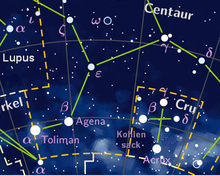Coal sack
| Dark fog | |
|---|---|
| Coal sack | |

|
|
| In the middle the Kohlensack dark nebula, above it on the right the Southern Cross in a photo from the European Southern Observatory . | |
| Constellation | southern Cross |
|
Position equinox : J2000.0 |
|
| Right ascension | 12h 50m |
| declination | -62 ° 30 ′ |
| Further data | |
| Angular expansion |
5 ° × 7 ° |
| distance |
500–600 ly |
| diameter | 30 × 35 ly |
| history | |
| Catalog names | |
| Aladin previewer | |
The Coal Sack is one of the most famous dark clouds in the sky and, along with Horsehead Nebula , Cone Nebula and others, it is also one of the few objects of its kind with a proper name. The coal sack stands in the middle of the southern Milky Way , between the constellations Crux (Southern Cross), the centaur surrounding it and the fly (Musca). It is 500 to 600 light years away and forms a noticeable “hole” in the surrounding, very star-rich area. Well-known objects at "binoculars" are the Carina Nebula and the Open Star Cluster NGC 4755 , which John Herschel called the jewel box .
The Aborigines in Australia know the series of dark clouds from the constellation Schild in the north down to the Coal Sack also as the Emu - with the Coal Sack as a head.
The astronomer Kalevi Mattila was able to determine in 1970 that the dark nebula is not completely black, but rather shines very weakly (about 10% of the light of the Milky Way behind it ). This is caused by the light reflex of the darkened stars behind it.
Trivia
The mist also plays a central role in the novel The Shard in the Eye of God by Larry Niven and Jerry Pournelle .
Web links
- SIMBAD: Coal Sack Nebula
- ESO: Parts of the coal sack in close-up including pictures and animation
Individual evidence
- ^ Kalevi Mattila : Interpretation of the surface brightness of dark nebulae . In: Astronomy & Astrophysics . tape 9 , 1970, ISSN 0004-6361 , pp. 53–63 , bibcode : 1970A & A ..... 9 ... 53M (English).

